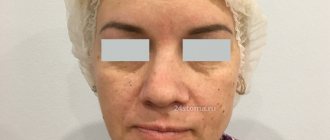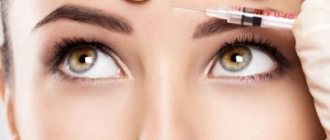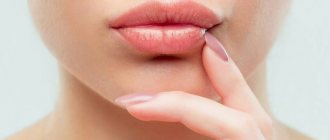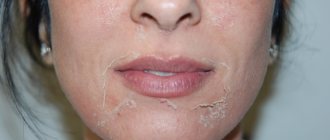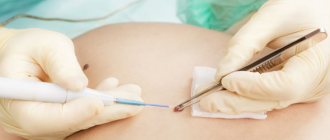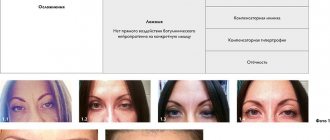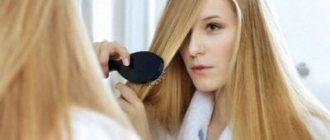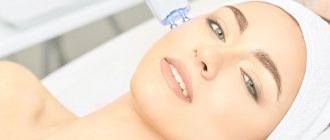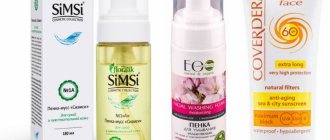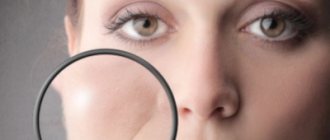Varieties
There are three types of folds:
- Stroke-fold. This is a shallow wrinkle associated primarily with dryness of the epidermis. This defect is characteristic of the fine-wrinkled type of aging.
- Gap-fold. A deep crease that appears due to changes in the dermis and subcutaneous structures. Typically found in muscular or fatigued morphotypes.
- Gradient fold. Sagging of the skin due to a sharp change in relief during the transition from the cheek to the nasolabial triangle. This phenomenon is characteristic of the deformational type of aging - the fold is formed as a result of an increase in the layer of subcutaneous fat (formation of the nasolabial fold).
Depending on the type of defect, a treatment strategy is developed. Sometimes one procedure may be enough; sometimes a combination of various injection and hardware methods is required to eliminate wrinkles. There is no universal method that would suit everyone and have no disadvantages, but in each case an effective solution can be found.
Let's start our review with the most accessible methods.
Contour plastic surgery prices
| Service code | Area of influence / List of procedures / Drug | Price |
| А11.01.012 | TEOSYAL TOUCH UP (0.5 ML) | 11900 |
| А11.01.012 | PRINCESS VOLUME (1 ML) | 14000 |
| А11.01.012 | JUVEDERM ULTRA 3 (1 ML) | 16500 |
| А11.01.012 | TEOSYAL GLOBAL ACTION (1 ML) | 18400 |
| A11.01.013 | REGENYAL IDEA (1 ML) | 20000 |
| А11.01.012 | TEOSYAL KISS (1 ML) | 20400 |
| А11.01.012 | TEOSYAL RHA 3 (1 ML) | 22000 |
*
— the price is indicated in rubles
Purchase a gift certificate for the procedure
The procedure is carried out in clinics
on Novy Arbat
on Barclay
on Nikulinskaya
The procedure is carried out by our specialists
Rybinskaya Nina Germanovna
Chief physician
Doctor of the highest category.
Dermatovenerologist, physiotherapist, winner in the category of the best specialist in hardware cosmetology of the “Grace” award. Imaeva Natalia Alexandrovna
Head of the clinic
Candidate of Medical Sciences.
Dermatovenerologist, cosmetologist. Certified specialist in the field of laser therapy, injection and hardware techniques. Petrova Ilmira Farkhadovna
Head of the clinic
Cosmetologist, trichologist.
Certified specialist in the field of laser therapy, injection and hardware techniques. Larina Sofya Vladimirovna
Leading Specialist
Dermatovenerologist, cosmetologist.
Certified specialist in the field of laser therapy, injection and hardware techniques. Savina Galina Sergeevna
Cosmetologist-esthetician
Certified specialist in the field of injection and hardware techniques.
SIGN UP FOR A CONSULTATION
The effect of contour plastic surgery of nasolabial folds
Cosmetic masks
If we are talking about shallow line folds that appear as a result of drying out of the epidermis, then moisturizing procedures will help eliminate the defect. Masks that hydrate the skin and increase its elasticity will also be useful for preventing the occurrence of such changes. Alginate masks will help with emerging gradient folds. To choose effective products, it is better to contact a cosmetologist: the doctor will recommend suitable products taking into account the individual needs of the skin.
Do not overestimate cosmetic masks - they are intended, first of all, to prevent the appearance of wrinkles. If deep furrows have already appeared on the skin, it is unlikely that you will be able to get rid of them with the help of cosmetics.
Indications for cheekbone correction with fillers
The main indication for the procedure is dissatisfaction with one's appearance, a natural desire to make one's body more harmonious and attractive. Other indications for correction include:
- unpronounced, flat or asymmetrical cheekbones;
- sunken cheek area without a pronounced fat layer;
- jowls - sagging areas of the cheeks with reduced tone and thinned subcutaneous fat;
- swelling of the oval of the face associated with age-related changes;
- congenital anomalies of facial development;
- prolapse of the zygomatic areas.
The likelihood of developing allergic reactions is minimal. If desired, you can combine several aesthetic procedures in one visit to a cosmetologist.
Massage
A properly performed massage improves blood circulation, stimulates metabolism and helps tighten the shape of the face. It will not be possible to completely eliminate nasolabial wrinkles in this way, but making them less pronounced is quite possible. In addition, massage is also good for preventing the appearance of creases.
Please note that we are talking about a professional massage, which is performed by a specialist who is well versed in human anatomy and physiology. Regular kneading of the face will be useless at best. An inept massage can cause harm if it intensively stretches the skin in the wrong directions.
Home methods are attractive due to their accessibility, but their effectiveness leaves much to be desired. If nasolabial folds have already appeared and they are quite pronounced, you will not be able to get rid of them on your own - you will have to turn to professionals.
What drugs can be used to eliminate nasolabial folds?
Mesotherapy of nasolabial folds can be performed using complex cocktails and single preparations. Professionals actively use substances such as:
- Magnesium and silicon salts – improve skin, tissue structure, increase elasticity;
- Phospholipids are a substance found in cell membranes. It is responsible for elasticity;
- Polylactic acid – forms neocollagen;
- Hyaluronic acid – used as a single preparation and in cocktails. Helps retain moisture in the skin.
Biologically active substances, vitamins, corticosteroids, enzymes, and immunomodulators can also be used. In total, there are over 200 cocktail recipes in cosmetology. Substances should be selected based on the degree of age-related changes in the face and skin structure.
Botulinum toxin injections
Preparations based on botulinum toxin are muscle relaxants - they relax muscles and relieve spasms. The skin over the relaxed muscles is smoothed out, and the wrinkles on it disappear. The technique is actively used to correct facial wrinkles - most often in the upper third of the face, but sometimes gap folds can also be removed with the help of botulinum toxin.
Treatment of this area requires special attention and skill from the cosmetologist - incorrect calculation of the dose can “freeze” facial expressions and negatively affect diction. This method is not suitable for everyone and not always, but it can be very effective if wrinkles are caused by spastic muscle contractions. The result lasts for a period of 4 to 10 months, depending on the dosage and individual characteristics of the body.
Fillers
Fillers are gels based on the same hyaluronic acid, but in a different form. Stabilized hyaluronic acid also moisturizes the skin, but its main purpose is to create volume at the injection site. Using injections, the cosmetologist introduces gels into those areas where there is not enough volume - for example, into creases in the skin - and the relief is instantly evened out. The effect is completely natural and lasts for up to two years.
When correcting nasolabial folds, injections can be performed not only in the problem area. If you slightly enlarge the cheekbones, the skin will tighten and the folds in the nasolabial triangle will straighten out. The cosmetologist makes the choice of technique after examination, depending on the structural features of the face.
Fillers are ideal for thin faces, but if the face is plump and also prone to swelling, then you should prefer another method of correction, for example, a thread lift.
Correction of nasolabial folds: procedure progress
Before directly starting to inject filler into the nasolabial folds, it is important to decide on the correct treatment strategy, because in this case there are 2 options for correction. The first option is that the filler is injected directly into the area of the nasolabial folds, using one of the injection techniques or a combination of them. The second option is that filler can be injected into the cheekbone area, which will increase their volume and tighten the skin + straighten the nasolabial folds.
In patients with pronounced cheekbones and round cheeks, it is best to actually correct the nasolabial folds themselves, however, in patients with thin cheeks and a small amount of soft tissue, it is better to inject filler into the cheekbone area, because this will give the best aesthetic result. Or a combined correction option is possible, when filler is injected into both the cheekbones and nasolabial folds (the choice of correction option will depend on the severity of the result you expect to see and your budget).
Above, we allowed ourselves to say that this is a fairly simple technique even for novice cosmetologists. This is true if we consider the complexity of correcting nasolabial folds with the correction of other areas of the face. But this relatively simple technique also has subtle points, some of which can make the procedure more effective, while others can lead to complications. Particular attention here should be paid to the upper third of the nasolabial fold, where the angular branch of the facial artery passes, and it is very important not to damage it and avoid embolism (24stoma.ru).
Contraindications to the procedure –
We should not immediately start injecting fillers into the nasolabial folds. At the first stage of communication with the patient, we must assess the medical history and the presence of contraindications to the procedure, after which the patient must fill out an informed consent form for filler injections. There are a number of contraindications for the use of fillers based on hyaluronic acid (including for the correction of nasolabial folds) -
- pregnancy and lactation,
- oncology (even if clinical recovery is achieved - at least 5 years must pass from this moment + permission from the oncologist has been obtained, since there is evidence that injections of hyaluronic acid can contribute to relapse),
- against the background of acute infectious diseases,
- inflammatory processes in the area of intervention,
- autoimmune diseases,
- tendency to form keloid scars,
- if the patient was previously injected with semi-permanent and permanent fillers in this area, or fillers of unknown origin.
In addition, if you have a pathology of the thyroid gland, then this can also be regarded as a relative contraindication. Against the background of this pathology, the destruction of fillers in tissues occurs much faster compared to ordinary patients, and therefore the duration of the effect can be several times shorter. The risk group also includes patients who often use corticosteroid ointments on the skin of the face (they develop granulomas much more often), people who abuse tanning, as well as patients with diabetes.
Choosing a filler for the procedure –
To correct nasolabial folds, denser fillers are used than, for example, to correct superficial wrinkles or to increase lip volume. The final choice will depend on the severity of the nasolabial folds: the deeper they are, the denser the filler with hyaluronic acid should be used. For example, for moderate folds you can use fillers Juvederm Ultra 3, Juvederm Volift, Restylane, Belotero Balance.
For deep folds – Juvederm Ultra 4, Restylane-Perline, Belotero Intense. All of the fillers listed above have FDA recommendations for the correction of nasolabial folds (with the exception of Juvederm Volift, as it is a recently introduced drug). There are a number of cheaper fillers - such as Princess Volume, Hyalax Base and others - that can also be used. However, these fillers are less flexible and behave worse in mobile areas; when used, gel displacement may occur more often.
As for the required volume of filler, usually 1.0 ml of filler is enough to correct moderately severe nasolabial folds (0.5 ml on each side). It is best to choose fillers without lidocaine for correction, because... the latter can lead to temporary whitening of the tissue at the injection site (especially with superficial injection), simulating ischemia, which is a symptom of vascular complications of the injection and requires urgent cessation of the procedure.
However, not only HA-based fillers, but also semi-permanent/permanent fillers can be used to correct nasolabial folds. Their undoubted advantage is their longer-lasting effect, but at the same time, the number of complications after their use reaches, according to various authors, even about 40-50%. Therefore, we still recommend using safer bioresorbable fillers based on hyaluronic acid.
Anesthesia –
If a 13 mm needle is used to correct nasolabial folds, then anesthesia is carried out using a cream or gel containing the anesthetic Lidocaine (the concentration of which in products of different brands varies from approximately 5 to 12%).
The cream is applied to the surface of the skin at the site of intended injection for about 20-25 minutes, after which it is washed off, and the skin is treated several times with antiseptic solutions. If the cannula technique is used, the injection site is numbed with an injection of local anesthetic. This again can be either Lidocaine, or Ultracaine, or some other anesthetics without or with a small content of vasoconstrictor components. Below we will look at the techniques of working with a needle and cannula separately.
Injection techniques (needle) –
In order to remove nasolabial folds, the linear-retrograde technique and its variations are used. For injections, a 13 mm long needle or a long flexible cannula can be used. The use of a needle implies that after injection, the needle moves parallel to the skin in the middle or deep layers of the dermis to the end to its entire length, and the material is removed with a retrograde movement of the needle back. We consider correction of nasolabial folds with a needle to be preferable, because... this anatomical area is relatively safe, and the needle is much easier to control in the tissue.
a) The first version of the classical linear technique implies that the filler is removed along the nasolabial fold, i.e. along it. To do this, needle injections are made at certain intervals of 13 mm to go through the entire length of the nasolabial fold (just short of reaching the wing of the nose, as well as the corner of the mouth). The first injection is made 13 mm from the wing of the nose, and at this moment it is very important to do an aspiration test. Injecting the needle to its full length each subsequent time, we should not immediately begin to remove the material, but first carry out a small separation of the tissues with characteristic movements of the needle (this is necessary for good distribution of the material).
Linear technique for correcting nasolabial folds: video
A complicated version of this technique is a fan technique (Fig. 3), when from one injection point not one linear pass is made with a needle with the material being removed while the needle moves retrogradely backwards, but several passes are made without completely removing the needle from the skin, each time changing its direction . Moreover, each time, remember to separate the tissue a little with a needle before removing the material. Do not forget about the aspiration test to prevent embolism of the angular branch of the facial artery, which runs near the wing of the nose.
b) The second option is to use a linear-retrograde technique in such a way that the material is removed perpendicular to the direction of the nasolabial fold in tracks of 10-12 mm (Fig. 5). First, we stretch the skin with our hands to completely smooth out the nasolabial fold. Next, we make sequential injections, moving in the direction from the wing of the nose to the corner of the mouth, perpendicular to the direction of the nasolabial fold. The material is removed by retrograde movement of the needle; each needle injection takes approximately 0.03 ml of filler, the distance between injections is 1.0-1.5 mm. In total, each nasolabial fold usually requires about 15-20 needle passes.
Important: there are a number of clinical studies comparing the effectiveness and duration of the results of the two above techniques. Moreover, for clarity, in the same patients, the correction was carried out as follows: the nasolabial fold on the left was filled with a linear technique along the direction of the fold, and on the right side, a linear technique with a perpendicular direction of injections was used. Below you can see the results of these techniques in before and after photos of patients (Fig. 5-6). Photos of patients are taken from a clinical study, which can be viewed here.
Please note that the appearance of those nasolabial folds (see Fig. 5-6, after 4 weeks), the correction of which was performed perpendicular to the direction of the fold with injections, is somewhat better than where the classic linear injection technique was used in the direction of the folds. However, the advantages of both techniques can be used simultaneously by using a third correction option.
c) The third option is a combination of the first two techniques. This option first involves a linear passage with a 13 mm needle along the entire length of the nasolabial fold (do not forget about separating the tissues before removing the material), after which we pass perpendicularly several times, leaving the so-called “stiffening ribs” at a distance of 5 mm from each other. Do not forget about the depth of needle insertion, so if the material is removed too superficially, both contouring of the material and its translucency through the skin are possible (Tyndall effect).
Injection techniques (cannula) –
To remove filler into tissue, not only 13 mm long needles can be used, but also long cannulas (have a blunt end). This method has the following advantages: firstly, there is only one injection point on each side, and secondly, there is less risk of damage and embolism to blood vessels. The insertion point for the cannula is near the corner of the mouth. The injection site must be numbed with an injection of local anesthetic.
Next, using a needle, we create a puncture in the skin and the direction of insertion of the cannula, and only after that we insert the cannula into the tissue, moving it to the base of the nasolabial fold at the wing of the nose. Before removing the material, it is advisable to separate the tissues by moving the tip of the cannula. Next, we make several passes (fan technique), removing the material with a retrograde movement of the cannula back. A digital passage of the excretion area is required.
Correction of nasolabial folds with cannulas: video
Mesothreads
If, with age, facial features become sagging and droop, it is not so easy to return them to their place. The invention of the thread lift made such correction possible (Correction of the nasolabial fold by restoring lost cheek volume compared to thread lifting: a comparative study). A frame of thin but durable biodegradable threads is formed under the skin, which holds the tissue, preventing it from sliding down.
At the same time, the threads stimulate the production of collagen and elastin, and the artificial frame is duplicated by the natural one, which is preserved even after the threads are absorbed. The result is visible after the first procedure and lasts for up to two years.
Using threads, you can tighten not only the skin, but also subcutaneous structures, so this method is perfect for correcting gradient folds.
Reviews about the procedure
Write a review All reviews
Sent by Maria
I noticed the appearance of “folds of grief” - I ran to Lantana, especially since I had already successfully improved my figure there. I know firsthand about the excellent professionals at the clinic. As always, Lantan turned out to be the best - I had the contour of my nasolabial folds corrected with filler, which not only corrected my face, but also nourished the skin!
Sent by Natalya She was unhappy with her thin lips and gave herself a birthday present - she signed up for Lantan. I also received a discount for the birthday boy! I love my lips so much now – they have simply transformed my face!
Laser tightening
Laser tightening is a hardware procedure, the effect of which is comparable to that of plastic surgery. The difference is that this is a much less traumatic intervention. It does not involve removing areas of skin, but changing the quality of the skin, causing it to shrink. It sounds fantastic, but it is true: due to micro-notches applied by laser radiation, the skin “shrinks”, becomes elastic and dense. As a result, wrinkles and folds are smoothed out.
A short course of procedures is required. By the end of the course, the face looks younger, the skin becomes denser, more elastic and smooth.
In mature patients with a large number of wrinkles, laser tightening can effectively complement surgery.
Selection of fillers and injection technique, restrictions after the procedure
The injection of fillers into deep fat compartments provides an upward lifting effect, while linear injection provides a lateral lifting effect.
- For deep fat pads, use the bolus injection technique and RHA4 or PureSense Ultra fillers.
- For superficial fat pads, use retrograde linear injection technique and RHA filler
- For nasolabial folds, use retrograde linear injection technique and RHA filler
Instead of PureSense Ultra Deep filler, you can use PureSense Ultra.
The amount of product administered to each area is selected individually for the patient, taking into account:
- degree of volume loss in the midface (with or without displacement of fat compartments);
- bone tissue structure;
- desired result;
- severity of nasolabial folds.
